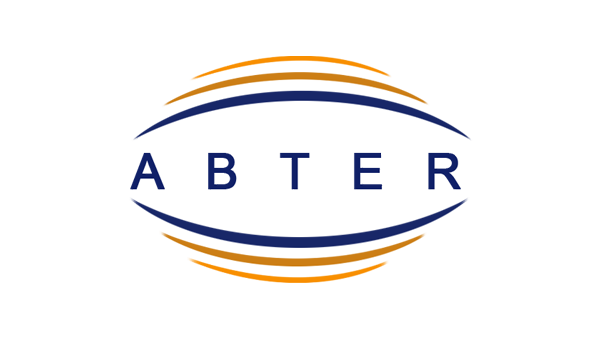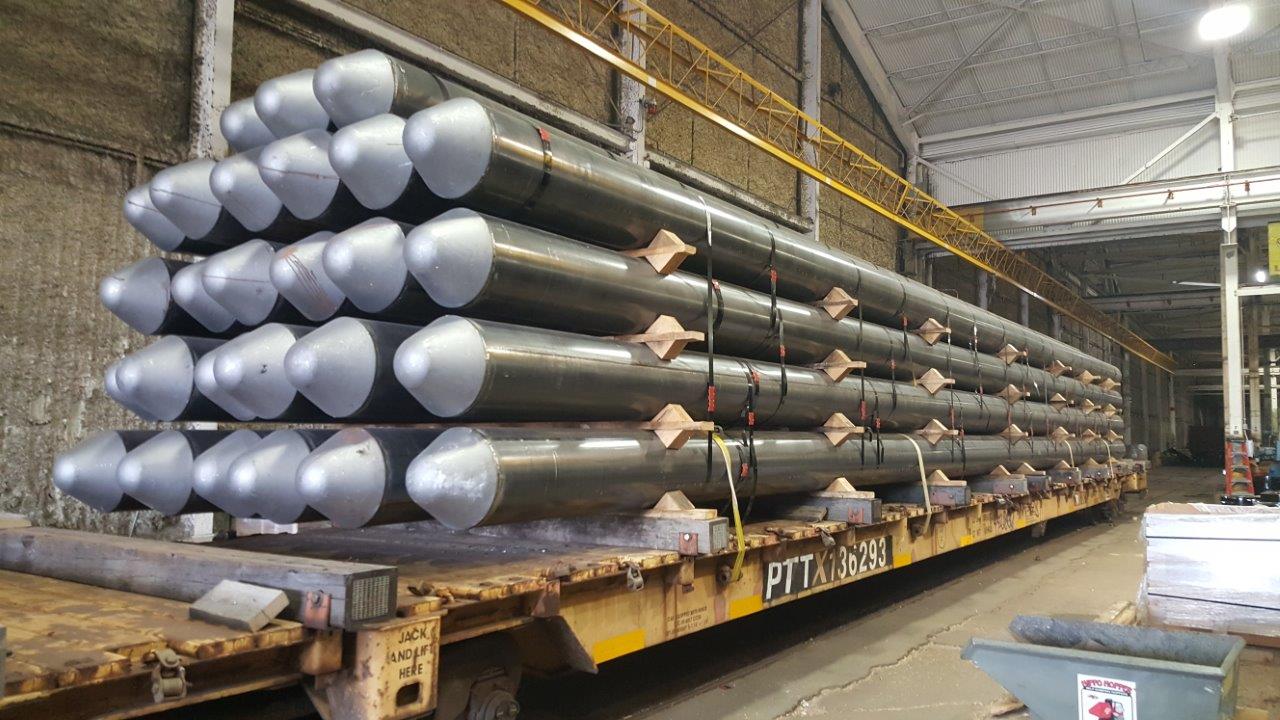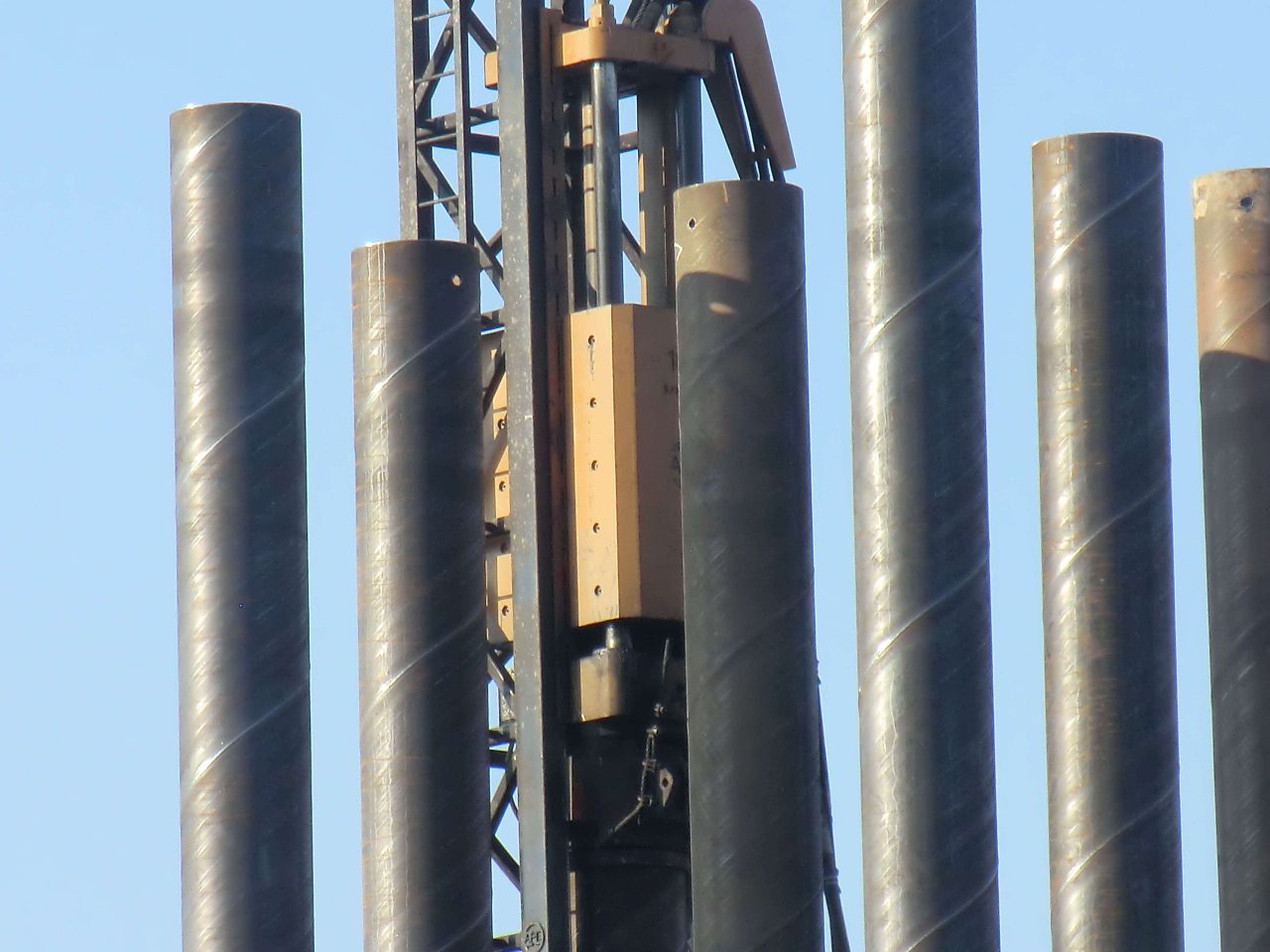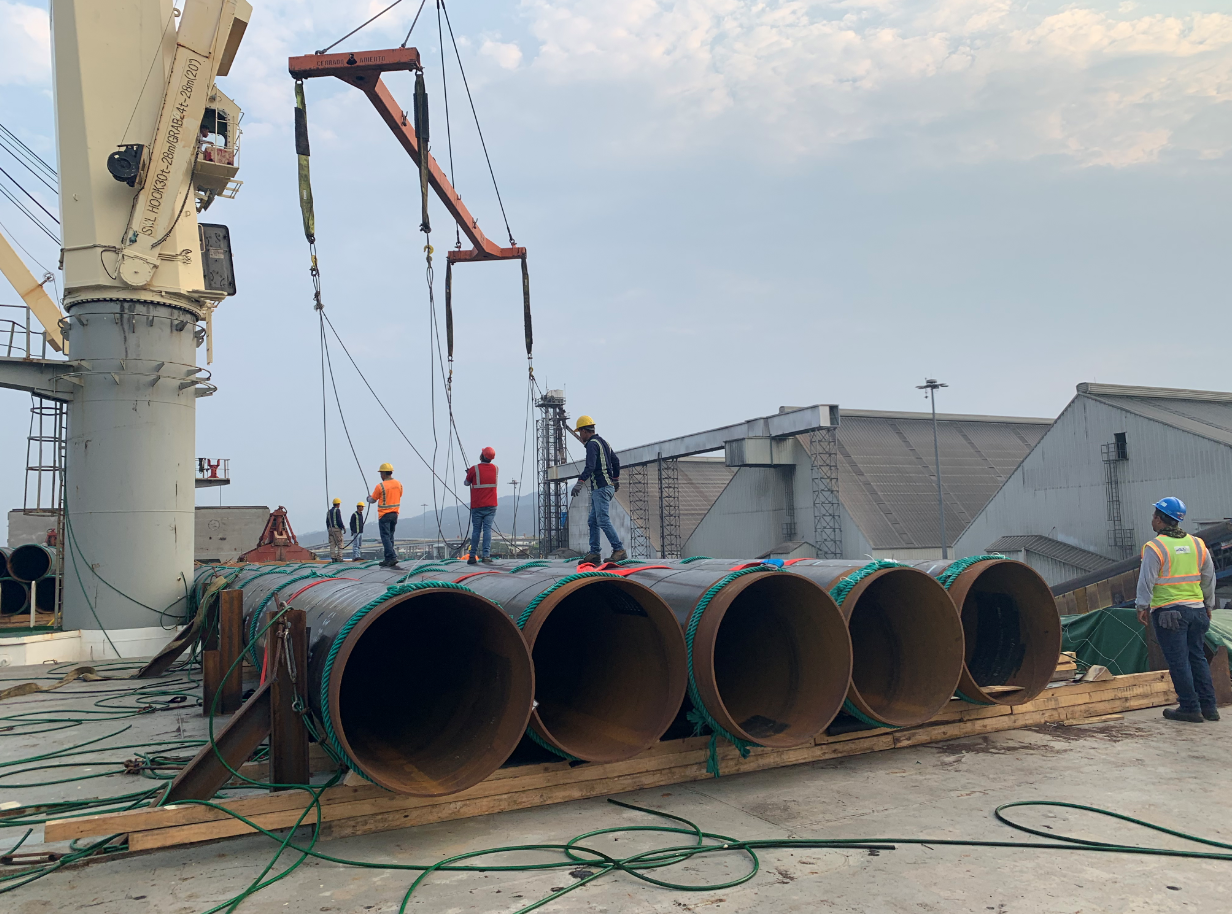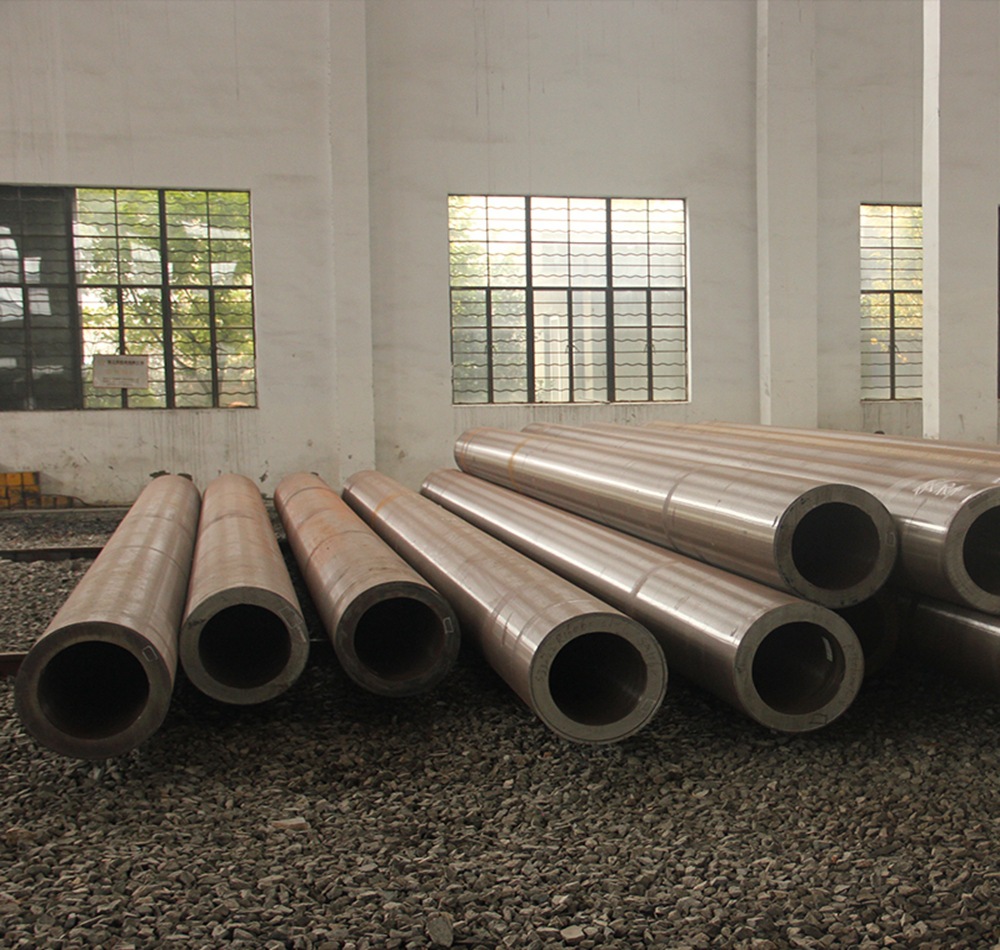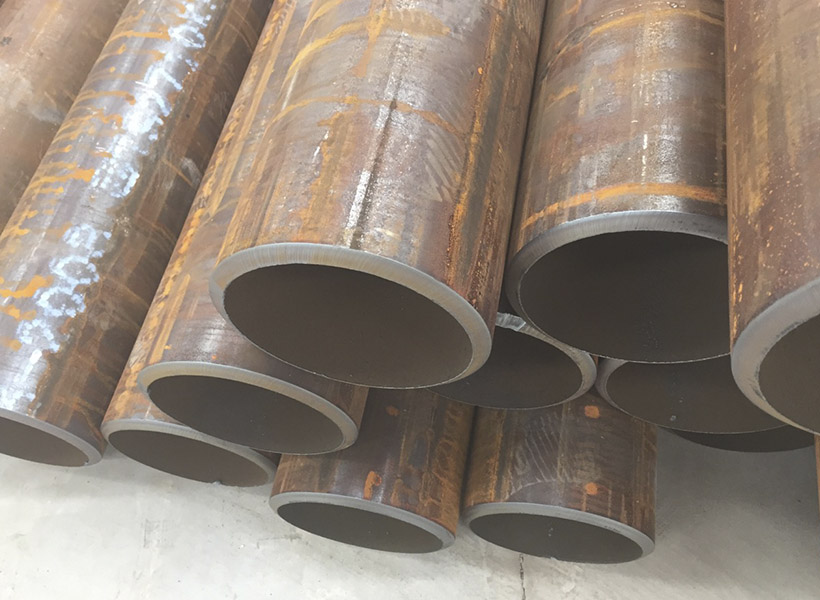Scientific Analysis of Installation Methods for Piling Pipes
Mechanics and Material Considerations in Pile Driving
Pile driving involves the forceful insertion of piling pipes, typically made of high-strength carbon steel or alloy steel (e.g., ASTM A252, API 5L grades X52-X80), into the ground using a pile driver that delivers impact energy via a hammer. The process relies on dynamic loading, where kinetic energy (0.5-2 MJ, depending on hammer size) is transferred to the pile, overcoming soil resistance through friction and end-bearing forces. Steel piling pipes, with outer diameters (OD) from 8” to 48” and wall thicknesses (WT) from 6 mm to 25 mm, offer high compressive strength (e.g., 483 MPa yield for X70) to withstand driving stresses. The soil’s shear strength and bearing capacity dictate penetration depth, with sandy soils requiring ~10-20 kN/m² resistance and clayey soils up to 100 kN/m². In bedrock, piles achieve end-bearing capacities exceeding 5,000 kN. Vibratory hammers, oscillating at 20-40 Hz, reduce soil friction, enabling faster installation in loose soils but are less effective in dense or cohesive strata. Standards like ASTM D1143 ensure proper driving procedures, minimizing pile damage. Challenges include pile buckling in soft soils and noise/vibration impacts, mitigated by pre-drilling or hydraulic hammers. This method’s efficiency—installing 10-20 piles daily—makes it ideal for bridges, high-rise foundations, and offshore structures.
Drilling Techniques and Geotechnical Interactions
Drilled piling, or bored piling, involves creating a borehole using rotary drilling, augering, or percussion methods, followed by placing a steel piling pipe (e.g., ASTM A252 Gr. 3, yield strength 310 MPa) into the hole, often filled with concrete or grout for added stability. The method suits complex geotechnical conditions, such as layered soils or bedrock, with ODs from 12” to 60” and WTs from 8 mm to 40 mm. End-bearing piles transfer loads to deep, stable strata (e.g., bedrock, bearing capacity >10 MPa), while friction piles rely on skin friction along the shaft (10-150 kN/m² in clay). Compaction piles densify loose soils, improving bearing capacity by 20-30%. Drilling rigs, delivering 50-200 kN-m torque, ensure precise installation, with depths reaching 60 m. Bentonite slurry or casing prevents borehole collapse in unstable soils. Standards like EN 1536 and ASTM D3966 govern installation, ensuring alignment and stability. Drilled piles excel in urban settings with minimal vibration but require longer installation times (1-2 piles/day) and skilled labor. Applications include high-rise buildings, retaining walls, and water-saturated soils, where they protect against scour and liquefaction.
Comparative Analysis and Performance Optimization
Driving and drilling methods for piling pipes differ in mechanics, cost, and suitability. Pile driving is faster (10-20 piles/day) and cost-effective ($50-100/m), ideal for uniform soils or offshore projects, but it risks pile damage in hard strata (e.g., stress >600 MPa) and generates noise (100-120 dB). Vibratory driving reduces soil resistance by 30-50% in sands, per ASTM D7383, but is less effective in clays. Drilled piles offer precision in complex strata, with load capacities up to 15,000 kN, but cost more ($100-200/m) due to equipment and time. Seamless steel pipes (e.g., API 5L X70) outperform welded in driving due to uniform strength, while welded pipes suffice for drilled applications. Corrosion in waterlogged soils (rate ~0.2 mm/year) is mitigated by coatings (e.g., epoxy, per AWWA C210) or cathodic protection. Future advancements include automated driving systems, real-time soil monitoring, and hybrid methods combining driving and drilling for efficiency. Selection depends on soil type, load, and site constraints: driving for speed in sands, drilling for precision in bedrock or urban areas.
Piling Pipe Specifications and Applications
| Method | OD Range | WT Range | Length Range | Standards | Applications |
|---|---|---|---|---|---|
| Pile Driving | 8” – 48” | 6-25 mm | Up to 20 m | ASTM A252, API 5L, EN 10219 | Bridges, offshore platforms, high-rises |
| Drilled Piles | 12” – 60” | 8-40 mm | Up to 60 m | ASTM D3966, EN 1536, API 5L | Retaining walls, deep foundations, urban |
Mechanical Properties of Piling Pipe Grades
| Standard | Grade | C (%) | Mn (%) | P (%) | S (%) | Tensile Strength (min MPa) | Yield Strength (min MPa) | Application |
|---|---|---|---|---|---|---|---|---|
| ASTM A252 | Gr. 3 | ≤0.26 | ≤1.35 | ≤0.035 | ≤0.035 | 455 | 310 | General piling |
| API 5L | X52 | ≤0.28 | ≤1.40 | ≤0.03 | ≤0.03 | 455 | 359 | Water, gas pipelines |
| API 5L | X70 | ≤0.12 | ≤1.70 | ≤0.025 | ≤0.015 | 570 | 483 | High-pressure piling |
| EN 10219 | S355 | ≤0.20 | ≤1.60 | ≤0.035 | ≤0.035 | 470 | 355 | Structural piling |
Extended Scientific Analysis of Installation Methods for Piling Pipes
Dynamic Load Transfer and Soil-Pile Interaction in Pile Driving
Pile driving relies on dynamic load transfer, where impact energy from a hammer (0.5-2 MJ) drives steel piling pipes (e.g., ASTM A252 Gr. 3, API 5L X70) into the ground, overcoming soil resistance through friction and end-bearing. The soil-pile interaction is governed by soil shear strength (10-100 kN/m² for sands to clays) and pile geometry (OD: 8”-48”, WT: 6-25 mm). High-strength steel grades, like X70 (yield strength 483 MPa, tensile 570 MPa), withstand compressive stresses up to 600 MPa during driving, per ASTM D1143. Vibratory drivers, operating at 20-40 Hz, reduce friction by 30-50% in granular soils, achieving penetration rates of 0.5-2 m/min, but struggle in cohesive clays due to high adhesion. In bedrock, end-bearing piles transfer loads (>5,000 kN) directly to stable strata. Challenges include pile buckling in soft soils (shear strength <20 kN/m²) and ground vibration (peak particle velocity 10-50 mm/s), mitigated by pre-drilling or hydraulic hammers. Research focuses on optimizing hammer energy and pile coatings (e.g., bitumen) to reduce friction, enhancing efficiency for bridges, offshore platforms, and high-rise foundations.
Geotechnical Precision and Drilling Methodologies
Drilled piling, or bored piling, employs rotary drilling, augering, or percussion to create boreholes, into which steel piling pipes (e.g., EN 10219 S355, OD: 12”-60”, WT: 8-40 mm) are placed, often with concrete or grout reinforcement. The method excels in complex geotechnical conditions, achieving depths up to 60 m with load capacities of 5,000-15,000 kN. End-bearing piles rely on bedrock (bearing capacity >10 MPa), while friction piles leverage shaft friction (10-150 kN/m²) in cohesive soils. Compaction piles densify loose sands, increasing bearing capacity by 20-30%. Drilling rigs, with torque of 50-200 kN-m, ensure precision, while bentonite slurry or temporary casings prevent borehole collapse in saturated soils. Standards like EN 1536 and ASTM D3966 mandate alignment tolerances (±50 mm) and grout strength (20-30 MPa). Challenges include slow installation (1-2 piles/day) and high costs ($100-200/m). Future advancements involve automated drilling systems and real-time geotechnical sensors to optimize pile placement in urban, water-saturated, or seismic zones, such as retaining walls and deep foundations.
Corrosion Protection and Long-Term Durability
Piling pipes in waterlogged or corrosive soils face degradation, with corrosion rates of 0.2-0.5 mm/year for unprotected carbon steel (e.g., API 5L X52). Protective measures include epoxy coatings (AWWA C210, 250-500 μm thick), reducing rates to <0.05 mm/year, and cathodic protection (-850 mV vs. Cu/CuSO₄), extending life to 50+ years. Welded joints in driven piles, formed via SAW, are vulnerable to stress corrosion cracking (SCC) in chloride-rich soils, necessitating robust coatings or stainless steel alternatives (e.g., UNS S31803). Drilled piles, often encased in concrete, benefit from alkaline environments (pH >12), passivating steel surfaces. Research explores nanocomposite coatings and sacrificial anodes for enhanced protection. Delivery (within 30 days) and payment options (TT, LC, OA, D/P) ensure accessibility. Future innovations include self-healing coatings and IoT-based corrosion monitoring to maintain structural integrity in aggressive environments like marine or industrial sites.
